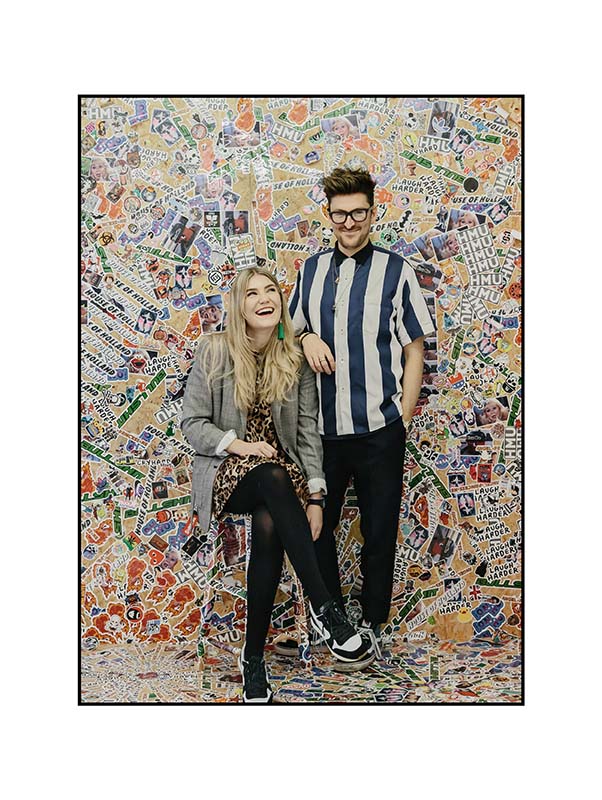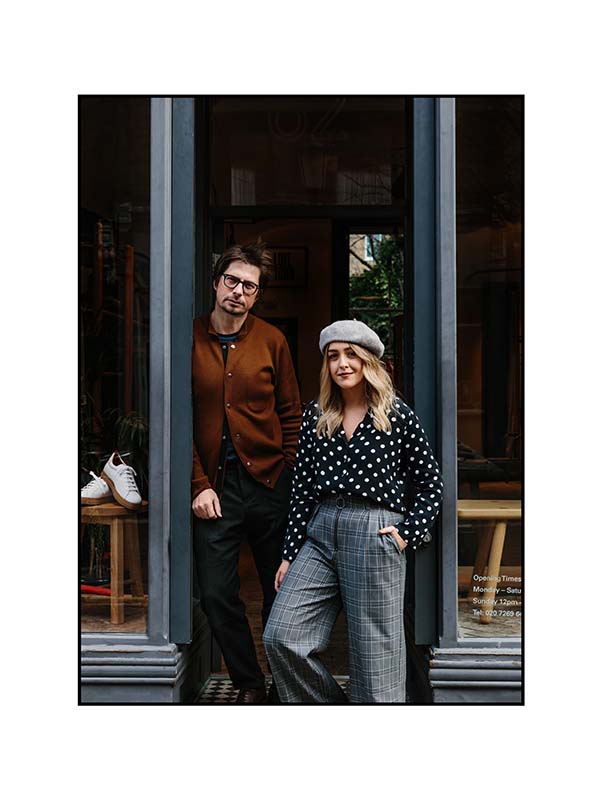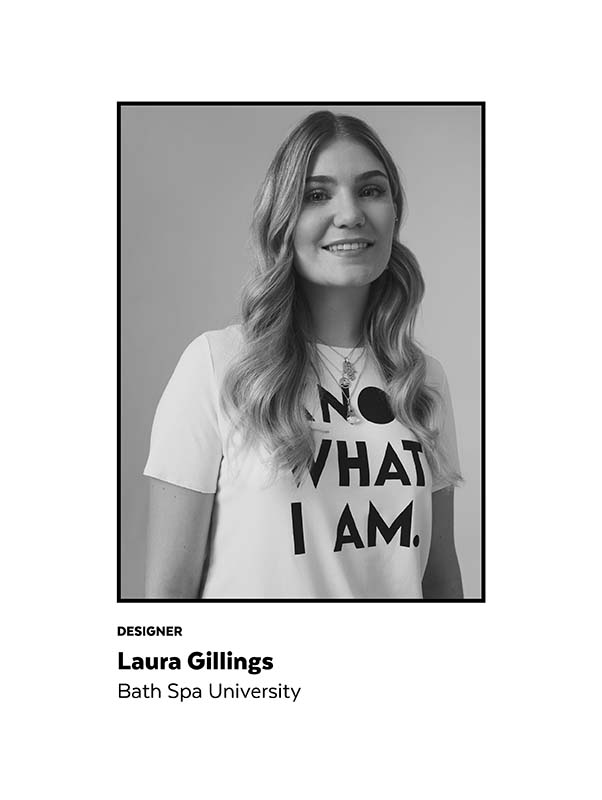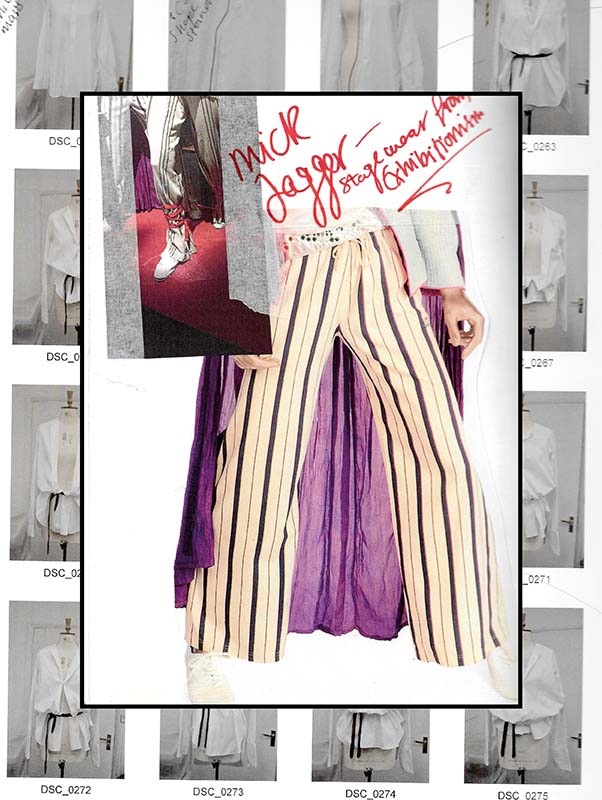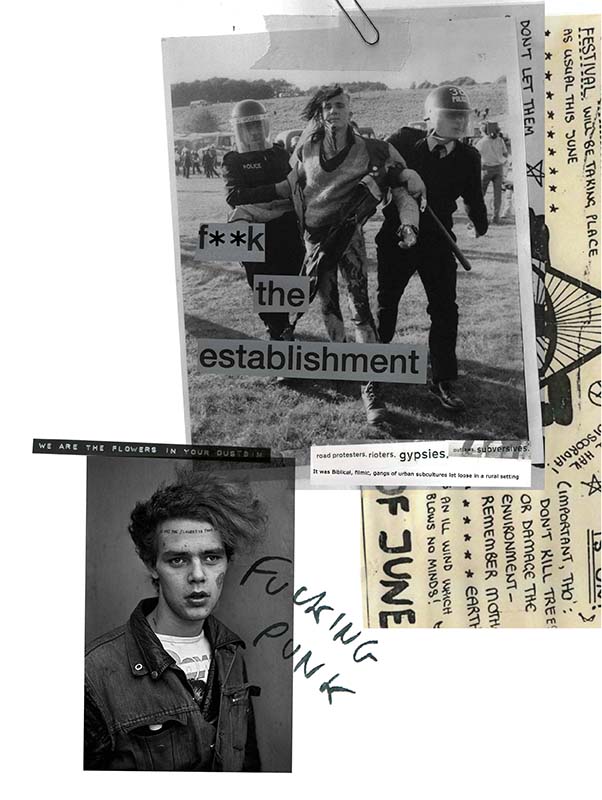Following on from the success of the first Graduate Fashion Week Collection in 2017, Tu has launched two new Graduate Fashion Week Collections for 2018, including their first Graduate Fashion Week Collection for Men.
Laura Gillings, from Bath Spa University, is the winner of the Tu Womenswear Scholarship, and has created a collection under the mentorship of renowned designer, Henry Holland. Amy Vanderwal, from Nottingham Trent University, is the first winner of the Tu Menswear Scholarship, mentored by celebrated menswear designer, Oliver Spencer.
As part of their scholarships, both Laura and Amy were also awarded a year’s paid employment with Tu, working within the Sainsbury’s head office alongside a large team of in-house designers, gaining valuable insight into the fashion industry from buying through to design. Under the careful supervision of their designer mentors, both graduates were given guidance to repurpose their winning final year collection for the consumer market, creating a capsule collection for Tu’s 2018 range.
Both Womenswear and Menswear collections are available on Tu.co.uk from today, with a second collection launching for Autumn Winter 2018. Read interviews with the mentors and alumni below!
WOMENSWEAR
The Womenswear collection, aptly named ‘The Hype of the Stripe’, takes inspiration from bold and unabashed 1960’s tailoring and the effortless cool of the Rolling stones. Designer Laura Gillings was inspired by Mick Jagger’s penchant for broad striped suits, symbolic of the feeling of individuality, creativity and freedom that the 60’s invoked. Soft tailoring is embellished with ruffles and nickel eyelets, whilst the empowering slogan 'I know what I want', adorns a simple white t-shirt.
“It’s been amazing to see my creations come to life and the team at Tu have kept true to my vision, making only the tiny necessary tweaks to ensure my runway collection is commercially viable. Working with the team has been the best part of this experience and I’ve realised that I want to make my career designing for the high street. I want my designs to be accessible to everyone.”
Laura Gillings, GFW17 Tu Scholarship Award Winner
“Laura’s bold aesthetic mirrors my own - she’s not afraid to play around with colour, exaggerated silhouettes, frills and even ruffles! Fashion is all about having fun in a really expressive way and I was proud to be part of the team that helped Laura realise her vision”
Henry Holland
Laura Gillings
Can you describe your collection and the inspiration behind it?
The collection started from looking at 1960s and 70s tailoring and rock and roll styling of the Rolling Stones. They were a really big influence. I also looked at their girlfriends – Anita Pallenberg was a really big inspiration. I love how they used to crossover clothes – menswear would be worn as womenswear. It didn't really have a gender.
“The stripes and tailored suits and coats of that time were a huge inspo. I found an amazing striped suit that Anita Pallenberg wore – I wanted to bring that into now. That also came through with the slogan T-shirts. I really wanted to do something that showed power. That you can be who you want to be and wear these really strong clothes that show your personality. I feel like a lot of people are scared to wear their personality. So I chose bold, bright colours on purpose, to stand out. It’s all about confident styling.
How has the collection evolved since the GFW show?
It hasn't evolved too much. There's a lot of pieces that went into work from my original samples, which is fantastic. Probably 70 per cent of it is still the same. And the other thirty was adding in solid colour pieces that make it easier to style for the everyday.
Are there any designers that have influenced or inspired your design aesthetic?
Not that it’s very vintage – it's 2003 – but there was this Marni jacket. A really bold, block red and white stripe that was very influential to this collection. It was a beach chair stripe and my coral and white suit came from that. I really loved the styling of it as well. I used a lot of vintage pieces… I deconstructed suits and looked at some shirts as well. I think using this as inspiration makes it more original.
What do you think is the most important lesson you've learned from this process?
It's that commercial clothes can be really bold and bright. And that you always have to think about the customer. But the customer can change with your designs and adapt. So you adapt with the customer and they adapt with you, it’s a two-way process.
What have you enjoyed most?
The process of seeing my designs come to life through the suppliers that we use. It was super-exciting getting the packages and seeing they’d made things exactly how I wanted.
What have you found hardest?
At first, I was really scared that I would have to change my collection drastically. But by just adding a few bits in, it actually felt fully finished.
Has the design team at Tu been a big support?
Definitely. My manager has been amazing. She's just gone on maternity leave and I feel like I've lost my fashion mum. She's helped me throughout the whole process and she's really helped with the buying side of it. I've never worked with buyers before and she’s helped me build a good relationship there so that when we're sourcing fabrics, they know exactly what I want. That it feels premium and needs to have a certain aesthetic.
What's it been like having Henry Holland as a mentor?
It's been really amazing for me to come in and show him my work and him be like, ‘Yeah, it's great.’ He really likes it, he's really supportive and he's been really optimistic about my collection.
What do you feel is the standout, must-buy piece from your collection?
The green jumper. The colour’s really rich and it's really easy to wear. It could be styled really cool or really simple. And even though it's a knitwear piece, the grassy green screams summer.
Henry Holland
How did you first get involved with GFW?
I first got involved years ago now. Along the way, I've judged different awards, done some mentoring and placements, so I've been involved at varying degrees over the last eight or nine years. Because I'm not a fashion graduate, I feel sense of duty to try and help the ones that are. I still have a bit of an imposter complex because I was a journalism graduate so I feel like I'm really fortunate to have been able to develop this career whilst not actually studying it.
Why do you think it's important to be involved in GFW?
The number of jobs versus the number of graduates is just so disproportionate that I think GFW is an amazing entity so I like supporting it. With something that's as vocational as fashion, there's an expectation to have a certain level of experience. Even right from the get go in terms of getting jobs. It’s such a difficult thing to ask of someone without asking them to work for free for a certain amount of time. GFW helps give graduates that platform.
Why did you choose Laura as the Tu scholarship winner over all the other contestants you saw?
It was a really hard decision when we were looking through all the applicants but I wanted to choose somebody that had a commercial approach to their design, that could work well into the Tu team structure. And that's what Laura was.
Some of the other applicants were almost too rigid in their own identity. After interviewing them, we realised they were very focused on areas they felt were part of their signature and DNA and these just wouldn't have translated or worked. And then other people had massively creative designs that just wouldn’t have translated, without completely bastardising their approach so you completely lost all sense of them. It wouldn't really be fair to do that.
Which piece from do you think will be an instant sell-out?
I would hope the lilac shirt. What's smart about it is the volume’s added somewhere that people are conscious about their figure and shape. A bigger sleeve gives you a smaller waist.
What's the best piece of advice you've ever been given?
Stay true to what it is you want to say through your work. It's very subjective what we do. Some people will love it, some people will hate it. If you stay very true to your brand DNA and your ethos, no one can take away from you. They might hate it, but at least it’s me. They can hate me, that's fine.
Would that be the piece of advice you'd give to aspiring designers as well?
I think it would be. The first part is figuring out what is your DNA and what you want to say. What are the things that make you, you? Then making sure that you don't veer away from that.
Did you have a mentor when you were starting out?
Not officially but I had a lot of friends in the industry so I used them a lot. Both for introductions to factories and suppliers and also for ideas, approaches and ways of doing things. Like Katie Hillier, she's a really good friend. And really early on, people like Stuart Vevers made me some handbags. I was really lucky in the fact that people I met socially got behind what I did and helped.
So it was more like a support network?
Definitely. London is a bit of a support network. There’s an amazing network there to be had. There's certain designers I can email about anything. And real level of respect around the challenges that we have, as well as the running of a fashion company and business. Also, we socialise together. That's essential. There's definitely some people that are more social than others. I'm not going to lie and say everyone's best friends but there's groups and really close partnerships where people will share information and help each other out.
Can you pinpoint the moment you knew you wanted to work in fashion?
When I moved to London. I grew up in the northwest, in a place called Ramsbottom, outside of Manchester. And fashion isn't a career choice that is ever spoken or heard of. It’s just not on the table. I knew from 13 I wanted to live in London so I only applied for universities there. But I think it's really hard to decide what you want to do at 17.
Not really knowing what I wanted to do, I applied for a journalism degree at London College of Communications, part of the University of the Arts London umbrella. I chose to do it to get a skill that was quite broad. So that I could then narrow that down to writing about a certain thing once I decided what that was.
I was living in halls with all the people from the different University of the Arts. There were people on fashion courses, and people on graphic design courses. This blew open all these doors of industries that I hadn't really considered before. And then after four days on that journalism course, I tried to move to fashion.
But I stuck with it and I’m so glad I did it. I went and worked for anyone and everyone that had fashion in the title. And that's how I found myself at Smash Hits by mistake. My sister knew someone in the advertising department. And then I was fashion editor at 21. So it was the right place for me.
MENSWEAR
Menswear takes its inspiration from another iconic era for British fashion, the 1980s, with a collection entitled ‘Stay Punk’. Designer Amy Vanderwal was heavily moved by documentary photographer Iain McKell’s fascination with the anarchistic Punk Hippie counterculture of the 1980’s and Colin O’Brien’s powerful images of traveller children. Juxtaposing punk and New Romanticism, Amy’s collection mixes youth culture with high concept commercialism in a highly wearable way.
“I’ve been on an incredible journey working with the team at Tu. I’ve worked closely with designers, buyers, merchandisers and of course my mentor Oliver. I‘ve really come to appreciate what an exciting and fast paced industry this is! From the collection I put on the runway, to the one that you will see in stores, I’ve learnt so much and really evolved as a designer.”
Amy Vanderwal, GFW17 Tu Menswear Scholarship Winner
“When Tu approached me to mentor the menswear programme, I instantly agreed as I'm very supportive of young forward-thinking designers. I wanted to be involved with Graduate Fashion Week as it's the future, it's inspiring. It's as inspiring for me as it is for them, I hope! I’ve really enjoyed seeing Amy grow from someone creative into someone who is also commercially minded, who I can see carving out a longstanding career within the industry.”
Oliver Spencer
Amy Vanderwal
Can you describe your collection and the inspiration behind it?
The initial graduate collection was inspired by the post-punk traveller movement that happened in the 1980s. It was all about rebelling against conformity and wearing what you want so that's where the idea of clashing prints came from. It was all about tartans clashing with bold stripes, clashing with the bleached denim. Fabric choices went against the conventional norms so you’d have a biker jacket but it would be in a suiting fabric. It was all about things that aren't really meant to be how they should be.
How has your collection evolved from your GFW show?
It's definitely been a journey. It's changed quite a lot from the initial collection. I had to work really hard to make sure that it’s wearable because when you look at it on the catwalk, it’s quite out there. I wanted to stay true to still keeping the punk, rebellious attitudes so I did that through the tartans, using the bold stripes and bleached denim but in a more commercial way.
Are there any designers that have influenced or inspired your design aesthetic?
Vivienne Westwood is known for her influence of when punk all began, she was basically one of the people that helped start it all. And her rebellious aesthetic is ongoing today. She influenced my handwriting quite a lot. But I also looked at people that draw inspiration from youth culture, like Raf Simons.
Do you think you'll stick with the subculture inspiration or will you try something totally different in future collections?
I think I'll always look towards youth culture because it's so prominent and that's what drives the industry. I find it really exciting so I think that will always continue through my handwriting but maybe it would steer away from punk slightly. I really like the idea of deconstructed tailoring so I think that would be something I'd like to continue with and keep as my specialism.
What have you enjoyed most?
I’ve enjoyed meeting and working with so many different creatives. I've worked really closely with the buyers and merchandisers at Tu. I've liaised with suppliers and been to their showrooms, and that's been really exciting. I also helped Oli with his fashion show in January. Working with all these different people helps you understand how fast paced and exciting the industry is.
What have you found hardest?
The hardest thing was probably translating what was an autumn/winter collection into a spring/summer collection. The whole attitude came from the knitwear and the coat so it was just ensuring that I was still using those really bold tartans and translating the print into lightweight fabrics. It took a lot of trial and error.
I’ve had to lose a few pieces along the way but I get to keep the samples so I give them to my dad. I had all these punk T-shirts that we did loads of different slogans on and we only selected three in the end.
What's it been like having Oliver Spencer as a mentor?
It’s been really good. The transition from uni to working in the industry is huge and you learn so much when you go into a job. Oliver’s got so much knowledge of menswear products and so much experience in the industry so it's nice to have someone there by my side who can give me guidance along the way.
He's also ensured I’ve got my own handwriting as a designer because it's important that you stand out from the rest, as it’s so competitive. He drilled it into me that I need to have this handwriting that I can carry through my whole career. His advice has been really helpful.
If you could imagine any celebrity, alive or dead, wearing this collection, who would you pick?
It would have to be David Bowie. I love how his style was so eclectic and he had so many different personalities. And how he used it as a way to present his individuality. He just wore what he wanted. I think that reflects what my collection is about. The dogtooth double breasted jacked is inspired by him, it’s a Bowie jacket.
Oliver Spencer
How did you first get involved with GFW?
Sainsbury’s were very generous towards my cancer charity Shine so all my time for them is because of that. I got approached by Tu – they asked me if I'd be interested in mentoring the menswear programme – and I'm very into the whole idea of apprentices and young forward-thinking designers coming through. It’s not a great market to be a young designer at the moment so this is definitely a foot in the right direction.
Why do you think it's important to be involved in GFW?
It's the future. It's inspiration. It's as inspiring for me as it is for them. I hope. It's a two-way relationship and it’s thrilling. Every time I'm constantly surprised. And I'm learning, which is great.
Why did you choose Amy as the Tu scholarship winner over all the other contestants you saw?
There were lots of great contestants and people who were doing equally as good things as Amy but Amy's collection struck me, as did her personality. I always try to look past the collection because I believe that's mega-important. I thought she'd probably be the most suited for Tu and what goes on out there.
How would you describe her design aesthetic?
At the moment she's kind of formulating it. It's coming to her. She's finding out about what she's doing which is a really exciting time. That's going to develop over the next couple of years into something that'll stretch from being exciting to commercial. And then hopefully she'll get the exciting bit and the commercial bit to come together.
The collection's quite grungy with a punk influence. Do you see that being a big trend for this year?
“Not necessarily but I don't think that matters either. What's important is that they're really good solid pieces with a lot of integrity. I feel as if we're at a turning point in culture in any case so I don't think it's necessarily out of fashion either. I think that we're going through a big change right now so I think it will work. I think it will work very well.”
“Also, you have to be not too literal with the word punk. The word punk is to disturb, to alter, to challenge. That's what it's all about. She’s challenging Tu as well.”
What trends do you see coming through this year?
Late 70s, early 80s. Lots of texture. Quite glamourous. I think people are getting their heads around what they’re meant to be wearing for work at the moment so that's playing a big part. The suit is becoming something more that you would go out in at night.
There's that blurring of lines between workwear and homewear. Pieces are just designed now to wear absolutely anywhere. It’s utilitarian and if you're making it in soft, beautiful fabrics then it'll work anywhere.
Which piece do you think will be an instant sell-out?
The blue and navy striped jumper. It's very cool. I think the denim drawstring trousers are really good. I also love the blue striped shirt.
What’s the best piece of advice you've ever been given?
See all, hear all, and say nothing.
Would that be the piece of advice you'd give to aspiring designers as well?
I’d say stay creative. But work for it.
Have you learned anything from working with Amy in this process?
I've learnt that you need to not be too opinionated and let people do what they're going to do. And that my role is to help the winners develop into what they need to become. It's helping develop instead of dictating what to do.
Spotted our winning womenswear collection yet? If not, check it out here.



